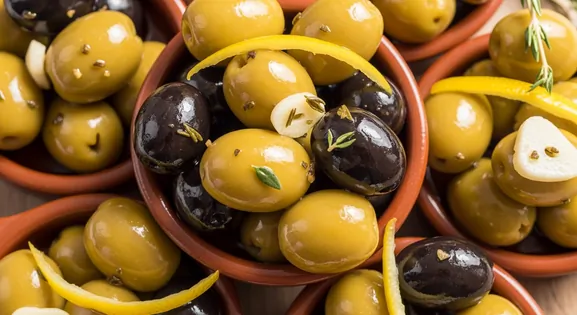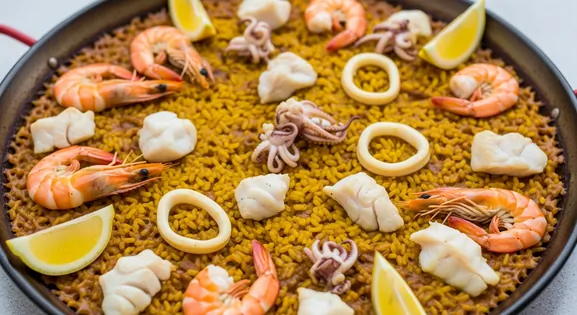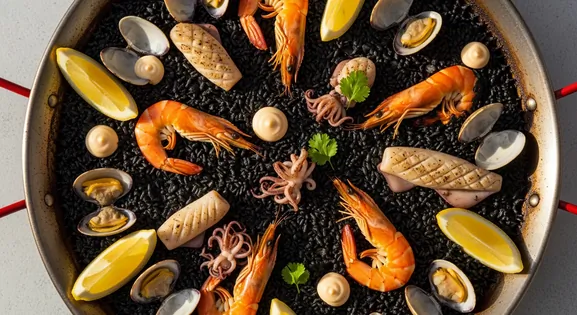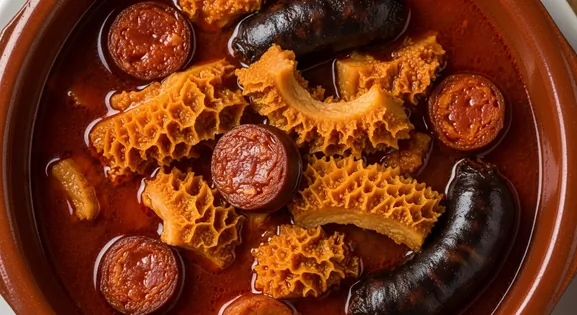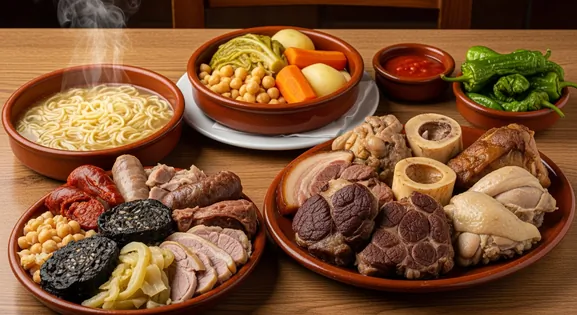Cazón en Adobo in Spain: A Complete Food Lover's Guide
Cazón en Adobo

The Basics of Cazón en Adobo (Marinated Dogfish)
Cazón en Adobo is a beloved Spanish tapa featuring dogfish (small shark) marinated in a tangy mixture of vinegar, garlic, and spices, then lightly floured and deep-fried to golden perfection. This iconic Andalusian dish offers a perfect balance of crispy exterior and tender, flavorful fish. It's traditionally served hot with lemon wedges as part of a tapas spread, a true culinary highlight of southern Spain.
The Culinary Legend of Cazón en Adobo (Marinated Dogfish)
Cazón en Adobo has deep roots in Andalusian cuisine, particularly in coastal provinces like Cádiz and maritime cities like Seville. The technique of marinating fish in adobo (vinegar and spices) dates back to Arab influence in medieval Spain, serving both as a flavor enhancer and preservation method. The dish became popular in taverns and tapas bars throughout the region, evolving into an essential part of Andalusia's 'pescaíto frito' (fried fish) tradition. Historically, it utilized affordable, abundant dogfish as a protein source for working-class families.
How It Is Traditionally Made
The preparation begins with marinating chunks of fresh dogfish in 'adobo' - a mixture of vinegar, garlic, oregano, cumin, paprika, and salt - for several hours or overnight. This process tenderizes the fish and infuses it with flavor. Just before serving, the marinated fish pieces are drained, lightly coated in flour (sometimes mixed with additional spices), and deep-fried in olive oil or sunflower oil until golden and crispy. The quick frying at high temperature ensures a crunchy exterior while keeping the interior moist and tender.
Key Ingredients of Cazón en Adobo (Marinated Dogfish)
Dogfish (Cazón)
A small shark species with firm, white, meaty flesh, ideal for marinating and frying. Its texture holds up well to the adobo and high heat.
Quality indicator: Look for firm, translucent flesh with a mild, fresh scent, not overly fishy.
Sherry Vinegar (Vinagre de Jerez)
A key component of the adobo marinade, providing the characteristic tangy and slightly nutty flavor. It tenderizes the fish and acts as a natural preservative.
Quality indicator: Opt for authentic Sherry vinegar with a Denomination of Origin (D.O.) for superior flavor and acidity.
Garlic and Spices (Ajo y Especias)
A blend of fresh garlic, oregano, cumin, and paprika creates the aromatic and savory base of the adobo, infusing the fish with deep flavor.
Quality indicator: Freshly crushed garlic and vibrant, aromatic spices indicate a well-prepared marinade.
Local Cazón en Adobo (Marinated Dogfish) Variations in Spain
Cazón en Adobo Traditional
The classic preparation with dogfish marinated in vinegar, garlic, and spices, then floured and fried. Served with lemon wedges.
Cazón Bienmesabe
A variation from Cádiz where the marinade includes white wine alongside vinegar, and sometimes includes saffron for color and flavor.
Cazón en Adobo with Alioli
Served with garlic mayonnaise (alioli) as a dipping sauce in addition to the traditional lemon wedges.
Cazón Frito
A simpler preparation where the fish is fried without the adobo marinade, seasoned only with salt, often part of a 'fritura mixta' (mixed fried seafood platter).
Modern Cazón Tapas
Contemporary interpretations might include cazón served on skewers, with fusion sauces, or as part of more elaborate dishes.
Enhancing the Flavor: Classic Pairings
Manzanilla or Fino Sherry
Wine
These dry, crisp sherries from Andalusia cut through the richness of the fried fish and complement the tangy adobo marinade, offering a refreshing contrast.
Crisp Lager Beer
Beverage
A cold, light Spanish lager provides a refreshing counterpoint to the savory, fried cazón, cleansing the palate and enhancing the overall enjoyment of the tapa.
An Authenticity Checklist
What to Look For
-
Fish fried to order, not pre-cooked and reheated
Fresh-fried cazón will be hot, crispy, and properly cooked through. Pre-cooked versions lose texture and quality, and may pose safety concerns.
-
Clean, fresh-smelling oil
The oil should be clear, not dark or smoky. Fresh oil ensures better flavor and eliminates harmful compounds from repeated frying.
-
Busy establishments with high turnover
Popular places serve fresher food as they replenish ingredients more frequently. Locals know where the best quality is found.
-
Golden, crisp exterior with moist interior
Properly cooked cazón has a light golden color and crispy coating, with juicy fish inside. This indicates correct cooking temperature and duration.
What to avoid
-
Strong fishy smell
Fresh cazón should not smell overly fishy. The aroma should be dominated by the vinegar marinade and spices, with just a mild seafood undertone.
-
Pre-fried fish sitting under heat lamps
This practice can lead to dry, soggy fish and potential bacterial growth if maintained at improper temperatures.
-
Very dark or burnt-looking exterior
This indicates either overcooked fish or the use of old, degraded oil, both of which reduce quality and potentially safety.
-
Chewy or rubbery texture
Properly prepared cazón should be tender. Tough texture suggests the fish is old, overcooked, or hasn't been properly marinated.
Explore Cazón en Adobo (Marinated Dogfish) in Detail: City Guides
Discover where to find the best Cazón en Adobo (Marinated Dogfish) and learn local tips in these cities:
Dietary Information
Dietary Information
Important Note for Travelers: Your safety is our priority. Below are the common allergens associated with the traditional preparation of this dish. However, recipes and ingredients can vary significantly between establishments. Always confirm all ingredients directly with the food vendor before ordering, especially if you have a severe allergy.
Potential Allergens
Dietary Suitability
How to Order Cazón en Adobo (Marinated Dogfish)
Frequently Asked Questions about Cazón en Adobo (Marinated Dogfish)
What is Cazón en Adobo?
Cazón en Adobo is a traditional Spanish dish consisting of dogfish (a small shark) marinated in a mixture called 'adobo' containing vinegar, garlic, oregano, cumin, and paprika, then coated in flour and deep-fried. The marination process tenderizes the fish and infuses it with flavor, while the frying creates a crispy exterior. It's a classic tapas dish particularly popular throughout Andalusia.
Is Cazón en Adobo a good choice for travelers?
When prepared with care, Cazón en Adobo is an excellent choice. The key factors are the freshness of the fish and proper cooking. Look for establishments with high turnover, where the dish is cooked to order and served hot. The traditional vinegar marinade (adobo) also contributes to the dish's quality. Choosing reputable venues where locals dine will likely lead to a high-quality, enjoyable experience.
What does Cazón en Adobo taste like?
Cazón en Adobo has a distinctive tangy flavor from the vinegar marinade, complemented by aromatic spices like oregano, cumin, and paprika. The fish itself has a firm, meaty texture similar to swordfish or monkfish (not flaky like other white fish). The exterior is crispy from frying, while the interior remains tender and juicy. The taste is savory with a slight acidic note, not fishy when properly prepared.
Is Cazón actually shark meat?
Yes, Cazón (Galeorhinus galeus) is a type of small shark, commonly known as dogfish. It's a traditional food source in coastal Spain, especially Andalusia. The meat is thoroughly marinated in vinegar and spices (adobo) before cooking, transforming its texture and flavor. It can be a sustainable alternative when sourced responsibly.
Is Cazón en Adobo gluten-free?
Traditional Cazón en Adobo is not gluten-free as it's coated in wheat flour before frying. While some modern places might offer gluten-free versions, it's uncommon in traditional tapas bars. Always inquire about ingredients and preparation if you have celiac disease or gluten sensitivity, as cross-contamination is possible.
How can I tell if Cazón en Adobo is fresh?
Fresh Cazón en Adobo has a crispy, golden exterior and a tender, juicy, white interior. It should have a pleasant tangy aroma from the marinade, not a strong fishy smell. Prioritize places that cook to order and have high customer turnover, as they typically serve the freshest product.
Expert How-To Guides about Cazón en Adobo (Marinated Dogfish)
How to Spot a Good Cazón en Adobo Vendor
Not all cazón en adobo is created equal. Look for these signs of quality and authenticity.
- Choose busy establishments with local customers, particularly in areas known for their seafood or tapas culture.
- Look for places cooking to order rather than displaying pre-fried fish. You should hear the sizzle of fresh frying.
- The exterior should be golden and crispy, not dark brown or soggy, indicating fresh oil and proper frying technique.
- The dish should be served hot immediately after cooking, never lukewarm.
- Quality vendors often garnish simply with fresh lemon wedges and perhaps a sprinkle of fresh parsley.
- Ask locals for recommendations - they often know the best spots for traditional fried fish.
How to Eat Cazón en Adobo Like a Local
To truly savor this traditional tapa, embrace the authentic Spanish way of enjoying it, enhancing both flavor and cultural experience.
- Squeeze fresh lemon juice over the fish just before eating - this brightens the flavor and is the traditional way to enjoy it.
- Pair with a cold, dry sherry like Manzanilla or Fino, or a crisp beer - these are classic Andalusian pairings.
- Eat with your fingers if served as a tapa (small plate), or with a fork if served as a larger portion.
- Take small bites to appreciate the contrast between the crispy exterior and tender interior.
- Share with friends in the Spanish tapas tradition - order several different dishes for the table.
- Eat immediately while hot and crispy for the best experience.
How to Identify Quality Cazón en Adobo
Understanding the hallmarks of a well-prepared Cazón en Adobo will elevate your culinary experience and ensure you enjoy an authentic, high-quality dish.
- The fish should be in evenly-sized, medium chunks - not too large (which prevents proper cooking) or too small (which makes them dry).
- The coating should be light and crispy, not thick or doughy. You should be able to see the outline of the fish through the coating.
- The color should be golden brown, not pale (undercooked) or dark brown (overcooked or fried in old oil).
- The aroma should feature vinegar and spices, without any strong fishy smell.
- When you bite into it, the fish should be moist and tender, never dry or rubbery.
- The flavor should be well-balanced with noticeable tanginess from the vinegar and notes of garlic and spices.
Our Commitment to Quality
At Tasteplorers, our mission is to provide the most accurate and useful travel information in the world. To achieve this, all content on this site is created through our unique editorial framework. We utilize leading AI research tools, guided by our proprietary prompts, and a multi-stage validation process. This entire system is overseen by our editorial team to ensure everything we publish meets our high standards for accuracy, cultural nuance, and practical value for travelers.
Learn more about our Editorial Process and our Mission.
Countries
Explore regions
Europe
Discover Europe's diverse culinary landscape, from Mediterranean flavors to hearty Alpine fare. Learn to navigate markets, decode menus, and eat like a local.
Latin America & Caribbean
Discover the vibrant cuisines of Latin America & the Caribbean. Our expert guide covers everything from Mexican street food to Peruvian ceviche and market tips.
Oceania
Explore Oceania's diverse food scene. Learn about Polynesian earth ovens, Fijian feasts, and the vibrant café culture of Australia and New Zealand.
Southeast Asia
Explore Southeast Asia's diverse food cultures from Thailand to Vietnam. Get expert tips on navigating spice levels, choosing quality vendors, and understanding the rich traditions of the region.
